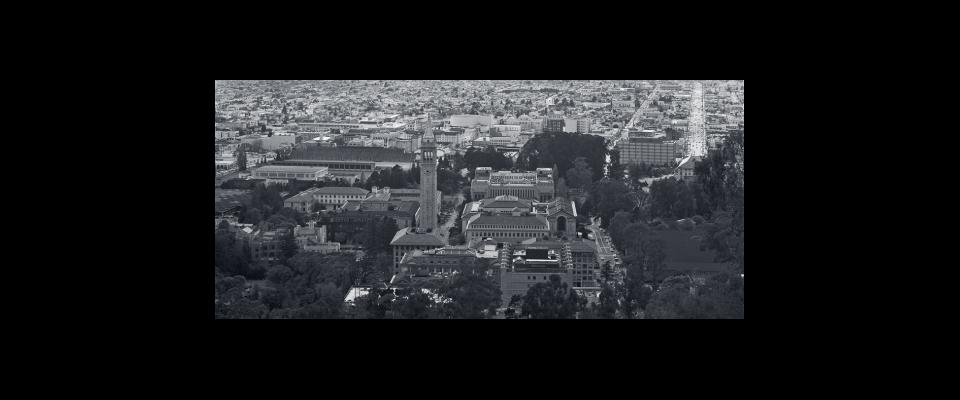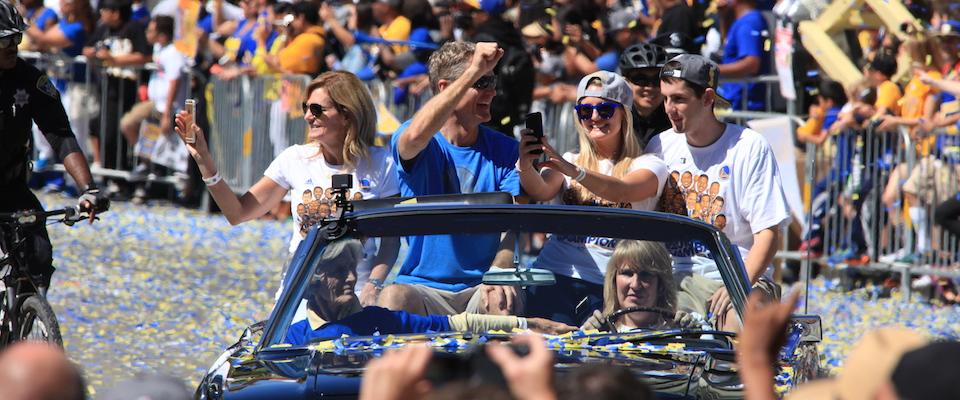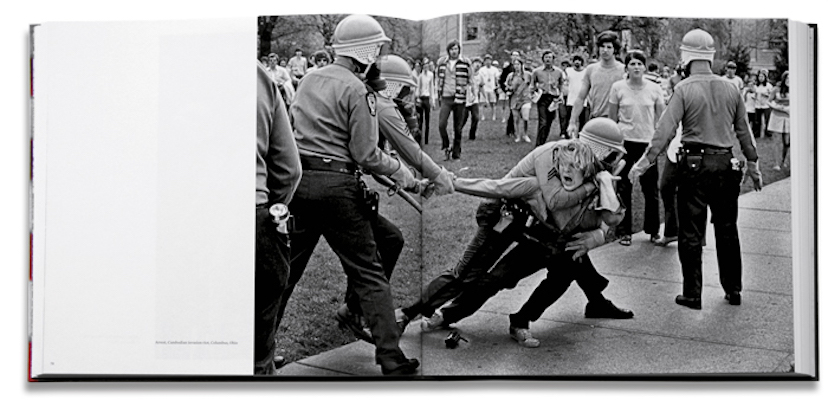The University’s take on Ansel Adams’s take on the University.
In 1964, Ansel Adams, the great landscape photographer, was commissioned by UC President Clark Kerr to produce a portfolio celebrating the University, its work, its people, its prospects.
Kerr was casting against type. Adams, a balding, bearded, crooked-nosed man, Rabelaisian, excited by ideas, self-taught, a lapsed concert pianist given to entertaining by playing chords with an orange (or if no fruit was handy, with his butt), was terrific in the company of human beings—but not particularly brilliant at photographing them. It was a shortcoming his critics loved pointing out.
“There is a person in every one of my photographs,” I once heard him grumble. That person, of course, was himself. But the critics were right; in all his best images, aside from that reflection of the eye of the artist, there is nobody else at all. It was a bold choice, then, for Clark Kerr to have picked Adams. And Adams, by abandoning the wilderness for campus—by trading the white, unworked granite of Half Dome for the neoclassical stone of the columns fronting Doe Library—was challenging the conventional wisdom about himself.
The photographer recruited a longtime collaborator, writer Nancy Newhall, and for three years the two traveled the wide realm of the University: all nine campuses, UC’s scattered system of nature reserves, and an assortment of agricultural projects and research sites all over the state. The result was published in 1967 as a stunning large-format book, Fiat Lux.
The title was perfect. Fiat Lux, “Let There Be Light,” is not just the University’s motto and the first biblical command, but also an expression of Kerr’s large vision for his institution and a nod to the medium of Adams’s art. If ever there was a master of light, it was Adams. The mastery was hard won, acquired over a long apprenticeship in the Sierra Nevada, John Muir’s “Range of Light.”
This year, after 45 years in shadow, Fiat Lux has come out into the brightness again.
The University’s program On the Same Page, which seeks to introduce incoming students to a common curriculum, sent a full-sized, facsimile edition of the book to all new students and the entire faculty. In September, the Bancroft Library launched an exhibit of original Adams prints, “Fiat Lux Redux,” to run through February 2013. This show will overlap, in the second half of February, with “Fiat Lux, Fiat Lunch, Fiat Futures,” an exhibition at the Worth Ryder Gallery in which Berkeley students, faculty, and community members try to envision the University’s future in a series of talks, performances, and multimedia collaborations. The season concludes in April at the Zellerbach Playhouse with “Aperture,” a dance concert inspired by the book.
The Fiat Lux revival is the brainchild of Professor Catherine Cole of the Department of Theater, Dance, and Performance Studies. Her idea has roots in Africa—first in Ghana, where she traveled about the country and studied a theater forum that took the place of newspapers; and then in South Africa, where she studied the workings of the Truth and Reconciliation Commission. “I’m drawn to theater that does some kind of engagement,” Cole says. “I’m really interested in how the arts can facilitate and participate in and catalyze conversation in communities and societies going through transition.” UC has been one such society, she feels, since at least June of 2009 when President Yudof announced a fiscal emergency, furloughs, and layoffs.
“The problem is, we don’t know who we are anymore,” Harry Nelson, a colleague from Cole’s stint at UC Santa Barbara, told her. “We’ve grown so big and diffuse, it’s hard to imagine by what process we would define ourselves.”
This struck a chord with Cole. When did we know who we were? She began reading Clark Kerr, which led her to an old copy of Fiat Lux, which led to the trove of original Adams prints at the Bancroft Library, and then to 6,700 Adams negatives at UC Riverside. These images suggested a university with an idea of who it was. She discovered, in showing slides from Fiat Lux, that they provoked big-picture conversation about UC. Here, she thought, might be the vehicle for a community discussion about the future of the University.
One component of the Fiat Lux revival is in “Take Five,” a series of interviews conducted by Professor Cole and videotaped by the filmmaker Kwame Braun, her husband, and viewable on YouTube. “We’re asking people to talk to these Adams images, and playing it back to the community for the conversations that it will spark,” says Cole.
This certainly worked with me. As the interviewees talked to the Adams images, I talked back, shouting disagreement at viewpoints I found fatuous, murmuring assent when someone made a good point. This is what Cole hoped for, more or less. (Maybe a little less, as she admits to being taken aback by the intensity of feeling stirred up by her project.)
The voices in the discordant chorus stirred up by Catherine Cole’s baton still have, to my ear, the ragged sound of an orchestra tuning up. The voices fall into two categories. There are those whose first and last instinct is to find fault with the Adams images, and by extension with the University—or with the University and, by extension, Adams. And there are those who look instead for something good in the Adams portfolio. The second group is generally older. I’m only guessing, but there seems to be a sort of gunslinger culture here: the young scholars thirsting for notches on their belts, and older scholars like Clint Eastwood in Unforgiven tired of all the killing and happy just tending their corn and beans.
Of the latter group, Sheldon Rothblatt, professor emeritus of history, is representative.
“I’ve been at Berkeley as a faculty member since 1963, and I was here as a student,” Rothblatt says in his interview. “The aesthetics, the music, the learning, all of that in my 18-year-old mind combined to make Berkeley just a new world, a new vision. Nothing else mattered for me in those years, but what the campus had to offer. So these photographs bring that back to me.”
Professor Rothblatt says no more about the photographs. Instead he shifts to Clark Kerr and Kerr’s love for the University, and then to the subject that Professor Cole hoped her Fiat Lux project would open up: the future of the University. It is curious, but the older group of Cole’s interviewees and panelists, with shorter futures before them, are the more likely to reflect on what lies ahead.
“The history of great universities indicates that they continue to be great,” declares Rosenblatt. “But they go through ups and downs.… So you have to ask yourself, how did the University survive, how did it surmount it, how did it bounce back? It is because there is inherent in the history of a great university a desire to find a way.“
The fault-finders, on the other hand, are more numerous.
“If you look at what Ansel Adams had, he had people barely moving,” Professor Nezar AlSayyad (architecture, Middle-Eastern studies) observes in his “Take Five” interview. “When he captured people, they were talking to each other in this still pose.” Associate Professor Leigh Raiford (African-American studies) makes the same point: “When people do appear, those images appear very staged; they’re very static and immobile.”
Exactly! This is still photography! The subjects don’t move. The two professors might have preferred blurred human figures suggestive of motion, a photojournalistic gimmick now in vogue—but that was not Ansel Adams. He came from another time and another tradition.
“What we get,” Professor AlSayyad says of Fiat Lux, “is the sort of roaming eye of Ansel Adams, literally bringing a certain aesthetic to the campus, finding the image that fits his mental image of what a university is like.” Yes! This is what an artist does! He or she brings an aesthetic to the subject matter. And yes, there is, indeed, this phenomenon of artistic subjectivity—in this case, Adams’s selective production of only those images he imagines tell the University story.
“It’s Ansel Adams, and he’s known for his work on landscapes and the beauty of California, the epic and the sublime,” says Professor Raiford, a specialist in race and photography, in her video interview. She hesitates, then carefully chooses her next words. “But as I found myself going back and looking through these images, I found myself really alienated from them, in a number of ways.”
Raiford opens Fiat Lux to Chapter 1 and its establishing shot, a photograph taken from the hills down past the campanile, across the campus and city, and out over the cloud-shadowed bay. “So this is the city on a hill, looking out through the Golden Gate,” she says. “Not only a broad view, but an imperial view of empire.”
An imperial view of empire? Public art is, granted, a transaction between the artist and the viewer, but most of the work is usually done by the artist. At what point does art interpretation tell us too much about the viewer and not enough about artistic intent?
In her “Take Five” interview, Julia Bryan-Wilson, an associate professor of modern and contemporary art, opens Fiat Lux to show us an Adams image of the Large Animal Clinic at UC Davis. She points out the instructor at the blackboard, and his chalk drawing there of a horse’s knee joint, and his several male students facing the blackboard with their backs to the camera. “And there’s almost this apparition of this horse head,” she muses. “Not only is the presence of the horse, I think, very somber, in some way. Just the fact that he’s kind of decapitated.”
To my eye, the horse is not somber at all, but humorous. He seems to be muttering an aside to the camera, some wisecrack, maybe, about the lack of horse sense in this veterinary professor. As for Adams’s “decapitation” of the horse, this is just the result of cropping. A picture must end someplace.
“But then I noticed that he has a bridle on,” Bryan-Wilson continues, “and the rope is being held by this very dark hand. Just at the edge of the frame. And it seems to me very curious that Adams would crop it in this way. That this person, whoever it is who’s holding this horse, is not part of the picture otherwise. I feel like it raises so many questions about what kind of invisible laborers make all of this happen. Who else are we not seeing in the frame?”
What else we are not seeing in the frame, in addition to the horse’s ass, is all of life and humanity and the entire sweep of the universe lying outside the frame. A picture can’t contain everything. The job of any photographer, painter, or poet is to select a piece of the cosmos and subject it to scrutiny. It is clever, maybe, to concentrate one’s critique on the obverse, commenting on everything else, but it seems a dirty trick on the artist, and disrespectful. Do we criticize The Grapes of Wrath because Anna Karenina makes no appearance there? Maybe nowadays we do.
Do I seem overly defensive about Adams and his pictures? I should confess here to my biases.
My family history with the photographer began in 1933, in the John Muir Wilderness of the Sierra Nevada, when my father, then 20, was descending from a climb of Pilot Knob. He met a bearded man walking up through the timberline forest with a tripod and camera over his shoulder. “You must be Ansel Adams,” my father ventured. The bearded man agreed. “Neither of us knew who I was,” my father would say of this moment.
He found out in short order, helped a good deal by Adams and his mentorship, but mainly informed by the mountains themselves. He turned out to be David Brower, a stalwart of the Sierra Club, who helped shift the outfit’s emphasis from hiking fraternity to conservation organization. Together, the two led the campaign to establish Kings Canyon National Park. Twice Adams proposed that my father head up the Sierra Club. On the second try he succeeded, and in 1952 David Brower became the organization’s first executive director. He and Adams went on to collaborate in a number of battles for wilderness preservation and reinvent Sierra Club publishing.
In the 1950s, as a boy at Adams’s house in San Francisco, I watched as he, Nancy Newhall, and my father transformed the epochal Sierra Club photo exhibition “This Is the American Earth” into a book. This oversized volume was in every way the model for Fiat Lux.
At the end of my freshman year at Berkeley, my father drafted me as editor on one of these big books, Not Man Apart, which combined the poetry of Robinson Jeffers and photographs of the Big Sur coast. By day, I canvassed Big Sur for images by the great photographers resident there, and in the evenings I brought the prints home to the Adams house. Occasionally Ansel would find fault with the composition. It was an arrogance, for these were the prints of accomplished photographers—Wynn Bullock, Morley Baer, Steve Crouch, all three Westons—but with four sheets of paper Ansel would set about recropping them. In a little at the top. A smidgeon off the bottom. His last adjustments on each of the four sides were in millimeters, and then came that moment: a kind of light switched on within the composition and it made the jump into inevitability. There was no other possible way to compose this picture. It was an electrifying thing to watch.
So here is my take on Ansel Adams, having observed him from my own infancy into his old age: In the history of his art, he was an unprecedented combination of technical virtuosity and inspired eye. He had trained to be a concert pianist until health issues forced him outdoors with a camera. His approach to photography—his perfectionism, his mastery of tonal scales, the operatic feeling in his grander images—was essentially musical. Adams was a genius. He took photography into a big, moody, exhilarating, Wagnerian country of inky peaks and dazzling snowfields where no photographer had climbed before.
The images in Fiat Lux are not his very best work, as pointed out by several critics of the present revival. He never quite surmounted his problems in portraying people—his genius simply did not lie there. It is striking how eagerly he seized every opportunity to shoot outdoors, under the skies of the University’s natural reserves and agricultural projects. Adams was a plein air photographer. His indoor images of cyclotrons and libraries and museums are technically brilliant and admirably composed, but the Adams magic is often not there. Still, for my part, one less-than-iconic Ansel Adams is worth three or four of the best images by almost anyone else.
Michael Pollan, professor in the Graduate School of Journalism since 2003 and author of The Omnivore’s Dilemma, The Botany of Desire, In Defense of Food, and other enormously successful books, sits for his interview in his office, wearing wire-rim glasses and a stubbly beard, turning the pages of Fiat Lux.
“What’s kind of amazing about these pictures is that the University is so much bigger than the little islands of buildings that we think of it as,” he says. “And that it reached out into the landscapes of California. Every part of that landscape…. This looks like a school that is building, that is extending out its tendrils to the landscape and has these beautiful research farms and wilderness areas. And there’s a great sense of anything’s possible.
“But of course this is all before Proposition 13. Right? This is a time capsule. This is what the public realm can do, prior to that turning point.”
Here Professor Cole, the interviewer, must have been pleased, for this is just the kind of discussion she hoped her project would spark: the big-picture perspective, a hint at the shape of the future, rumination on the University as a public good.
“The role of this University in creating California agriculture was critical,” Pollan goes on. “I was reminded of that, looking through here. Because nothing we knew about agriculture in the rest of the country really applied.… It really was like inventing agriculture on the moon, in a certain way. And this University had a lot to do with figuring out how it could be done. California agriculture is very different than agriculture anywhere else. It’s much more mechanized.”
Opposing mechanized agribusiness is exactly how Professor Pollan won his reputation, yet his approach to these images is not doctrinaire. He is willing to concede an epic quality to an agricultural system he believes is ruinous. He can see some heroism in the creation of a new agriculture in the California desert—in the invention of agriculture on the moon.
With an appreciative laugh, Pollan shows us the huge, silvery, gearlike wheels of a lettuce picker. An extraordinary machine, he says. He praises Adams for managing to include people, very specific people, in the frame. Pollan pauses to read aloud Nancy Newhall’s accompanying text: “‘With this machine, one man will replace perhaps a dozen men. An electronic sensor determines the maturity of the lettuce head,’—I thought that was pretty cool!—’a curved paddle grasps it, a knife cuts the stem, and a conveyor belt moves the lettuce to the waiting truck.'”
If, in the Michael Pollan scheme of things, there is something like an infernal machine, then this giant 1960s lettuce picker might be the prototype. Yet he does not come at it as an idealogue. He allows himself to be wowed by the machine.
After one panel discussion, in conversation with Alix Schwartz (College of Letters and Science), who is Catherine Cole’s right-hand woman in the Fiat Lux revival, I mentioned my surprise at the level of hostility to the Adams images. I was not prepared either, I confessed, for so much faultfinding, and so little charity, in the University’s commentary on itself.
“But that’s what we do!” Schwartz said. “We like to tear each other down.”
Having lived my whole life in Berkeley, I know this, of course, but somehow I always forget. I told Schwartz that for me Michael Pollan was one of the exceptions to her rule. I ventured that of all the Fiat Lux testimony I had heard, his was probably the wisest and most grown-up.
“But he comes from journalism!” she said. “He didn’t come up the normal route.”
I am an outsider, and doubtless a naïf, but I have an opinion: that if there is inherent in the history of a great university a desire to find a way, as Professor Rothblatt says, then the community of this university will need to come at the problem more as Pollan does—less captious, more willing to find things it likes about itself.




















